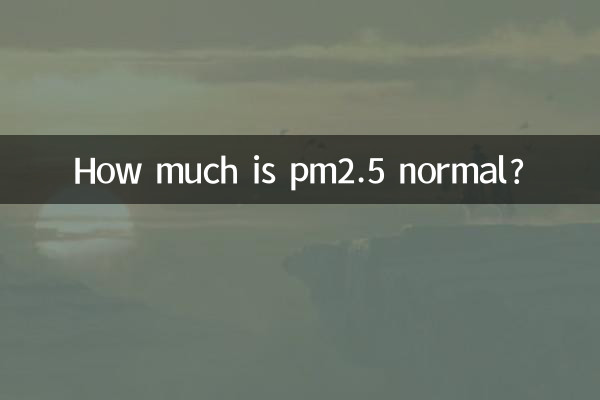How much PM2.5 is normal? Understanding air quality standards and health impacts
In recent years, as environmental pollution issues have attracted increasing attention, PM2.5, as an important indicator of air quality, has become a hot topic among the public. This article will combine the hot discussions on the Internet in the past 10 days to analyze the normal range, health effects and protective measures of PM2.5, and provide structured data for reference.
1. Normal range of PM2.5

PM2.5 refers to particulate matter in the air with a diameter less than or equal to 2.5 microns, and its concentration directly affects air quality. According to the standards of the World Health Organization (WHO) and environmental protection departments of various countries, the normal range of PM2.5 is as follows:
| Standard source | 24-hour average concentration (μg/m³) | Annual average concentration (μg/m³) |
|---|---|---|
| WHO recommended value | ≤25 | ≤10 |
| Chinese national standards | ≤75 | ≤35 |
| U.S. EPA standards | ≤35 | ≤12 |
As can be seen from the table, different countries and regions have different requirements for PM2.5 limit values, but WHO’s standards are the most stringent and aim to protect human health to the greatest extent.
2. Health effects of PM2.5
Exceeding the concentration of PM2.5 will cause many harms to human health. The following are common effects:
| PM2.5 concentration (μg/m³) | health effects |
|---|---|
| 0-35 | The air quality is good and there are basically no health risks |
| 35-75 | Sensitive people may experience respiratory discomfort |
| 75-150 | Healthy people may develop symptoms, but sensitive people are at significantly increased risk |
| 150 and above | Everyone’s health may be affected and outdoor activities need to be reduced |
3. Analysis of the correlation between recent hot topics and PM2.5
In the past 10 days, hot discussions about PM2.5 on the entire Internet have mainly focused on the following aspects:
1.High incidence of smog in winter: Many places in the north have entered the heating season. The increase in coal-burning emissions has led to an increase in PM2.5 concentrations, and many places have issued air pollution warnings.
2.New energy vehicles and air quality: The popularization of electric vehicles is hotly discussed. Data shows that promoting new energy vehicles can reduce PM2.5 emissions by about 15%-20%.
3.indoor air purification: During Double Eleven, air purifier sales increased by 30% year-on-year, reflecting the public’s emphasis on indoor PM2.5 control.
4. Protection suggestions
1.Pay attention to the Air Quality Index (AQI): Check the local PM2.5 concentration in real time through the authoritative platform and arrange outdoor activities reasonably.
2.Wear a professional mask: When the PM2.5 concentration exceeds 75, it is recommended to wear N95 or KN95 masks.
3.Improve indoor air quality: Use an air purifier to maintain indoor ventilation and reduce cooking fumes.
4.Participate in environmental protection activities: Choose public transportation, reduce fireworks and firecrackers, and report environmental violations.
5. Summary
The normal range of PM2.5 varies depending on the standard, but long-term exposure to an environment exceeding 35 μg/m³ may have adverse effects on health. In the face of the peak pollution period in winter, the public needs to increase their awareness of protection, and all sectors of society should work together to reduce pollution emissions. Only by continuously improving air quality can we achieve the goal of healthy living.

check the details

check the details